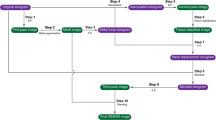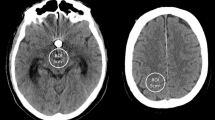Abstract
Purpose
This study evaluated the quality of computed tomography (CT) and CT angiography images generated using the single-energy metal artifact reduction (SEMAR) algorithm during perfusion examination in patients who had undergone reconstruction with neurosurgical clipping or endovascular coiling for treatment of aneurysms.
Methods
A total of 55 patients with implanted intracranial clips or coils (24 men and 31 women; mean age 60.15 ± 15.86 years) underwent perfusion studies evaluated by CT and CT angiography with a 320-row CT scanner. Images were reconstructed with either the SEMAR algorithm combined with iterative reconstruction (SEMAR group), or by iterative reconstruction only (non-SEMAR group control). The SEMAR and control images were compared for artifacts (index and maximum diameter), image quality, cerebral perfusion parameters, noise (images with the worst artifacts), and contrast-to-noise ratio. The metallic artifacts were visually evaluated by two radiologists using a four-point scale in a double-blinded manner.
Results
The noise, artifact diameter, and artifact index of the SEMAR images were significantly lower than that of the control images, and the subjective image quality score and contrast-to-noise ratio were significantly higher (P < 0.01, all). The cerebral perfusion parameters of the SEMAR and control images were comparable (i. e. blood flow, blood volume, and mean transit time).
Conclusion
For imaging intracranial metallic implants, the SEMAR algorithm produced images with significantly fewer artifacts than the iterative reconstruction alone, with no statistical changes in perfusion parameters. Thus, SEMAR reconstruction can be instrumental in improving CT image quality and may ultimately improve the detection of postoperative complications and patient prognosis.




Similar content being viewed by others
References
Keedy A. An overview of intracranial aneurysms. Mcgill J Med. 2006;9:141–6.
Morita A, Kimura T, Shojima M, Sameshima T, Nishihara T. Unruptured intracranial aneurysms: current perspectives on the origin and natural course, and quest for standards in the management strategy. Neurol Med Chir (Tokyo). 2010;50:777–87.
Shapiro M, Ollenschleger MD, Baccin C, Becske T, Spiegel GR, Wang Y, Song X, Raz E, Zumofen D, Potts MB, Nelson PK. Foreign body emboli following cerebrovascular interventions: clinical, radiographic, and histopathologic features. AJNR Am J Neuroradiol. 2015;36:2121–6.
Bharatha A, Yeung R, Durant D, Fox AJ, Aviv RI, Howard P, Thompson AL, Bartlett ES, Symons SP. Comparison of computed tomography angiography with digital subtraction angiography in the assessment of clipped intracranial aneurysms. J Comput Assist Tomogr. 2010;34:440–5.
Friedrich B, Wostrack M, Ringel F, Ryang YM, Forschler A, Waldt S, Zimmer C, Nittka M, Preibisch C. Novel metal artifact reduction techniques with use of slice-encoding metal artifact correction and view-angle tilting MR imaging for improved visualization of brain tissue near intracranial aneurysm clips. Clin Neuroradiol. 2016;26:31–7.
Barrett JF, Keat N. Artifacts in CT: recognition and avoidance. Radiographics. 2004;24:1679–91.
Lee MJ, Kim S, Lee SA, Song HT, Huh YM, Kim DH, Han SH, Suh JS. Overcoming artifacts from metallic orthopedic implants at high-field-strength MR imaging and multi-detector CT. Radiographics. 2007;27:791–803.
Fang J, Zhang D, Wilcox C, Heidinger B, Raptopoulos V, Brook A, Brook OR. Metal implants on CT: comparison of iterative reconstruction algorithms for reduction of metal artifacts with single energy and spectral CT scanning in a phantom model. Abdom Radiol (NY). 2017;42(3):742–8.
Morsbach F, Wurnig M, Kunz DM, Krauss A, Schmidt B, Kollias SS, Alkadhi H. Metal artefact reduction from dental hardware in carotid CT angiography using iterative reconstructions. Eur Radiol. 2013;23:2687–94.
Morsbach F, Bickelhaupt S, Wanner GA, Krauss A, Schmidt B, Alkadhi H. Reduction of metal artifacts from hip prostheses on CT images of the pelvis: value of iterative reconstructions. Radiology. 2013;268:237–44.
Funama Y, Taguchi K, Utsunomiya D, Oda S, Hirata K, Yuki H, Kidoh M, Hatemura M, Yamashita Y. A newly-developed metal artifact reduction algorithm improves the visibility of oral cavity lesions on 320-MDCT volume scans. Phys Med. 2015;31:66–71.
Kidoh M, Utsunomiya D, Ikeda O, Tamura Y, Oda S, Funama Y, Yuki H, Nakaura T, Kawano T, Hirai T, Yamashita Y. Reduction of metallic coil artefacts in computed tomography body imaging: effects of a new single-energy metal artefact reduction algorithm. Eur Radiol. 2016;26:1378–86.
Sonoda A, Nitta N, Ushio N, Nagatani Y, Okumura N, Otani H, Murata K. Evaluation of the quality of CT images acquired with the single energy metal artifact reduction (SEMAR) algorithm in patients with hip and dental prostheses and aneurysm embolization coils. Jpn J Radiol. 2015;33:710–6.
Yasaka K, Maeda E, Hanaoka S, Katsura M, Sato J, Ohtomo K. Single-energy metal artifact reduction for helical computed tomography of the pelvis in patients with metal hip prostheses. Jpn J Radiol. 2016;34:625–32.
Gondim Teixeira PA, Meyer JB, Baumann C, Raymond A, Sirveaux F, Coudane H, Blum A. Total hip prosthesis CT with single-energy projection-based metallic artifact reduction: impact on the visualization of specific periprosthetic soft tissue structures. Skeletal Radiol. 2014;43:1237–46.
Douglas-Akinwande AC, Buckwalter KA, Rydberg J, Rankin JL, Choplin RH. Multichannel CT: evaluating the spine in postoperative patients with orthopedic hardware. Radiographics. 2006;26(Suppl 1):S97–S110.
Brook OR, Gourtsoyianni S, Brook A, Mahadevan A, Wilcox C, Raptopoulos V. Spectral CT with metal artifacts reduction software for improvement of tumor visibility in the vicinity of gold fiducial markers. Radiology. 2012;263:696–705.
Geisel D, Gebauer B, Malinowski M, Stockmann M, Denecke T. Comparison of CT and MRI artefacts from coils and vascular plugs used for portal vein embolization. Eur J Radiol. 2014;83:692–5.
Venema HW, den Heeten GJ. Subtraction helical CT angiography of intra- and extracranial vessels: technical considerations and preliminary experience – rediscovery of matched mask bone elimination? AJNR Am J Neuroradiol. 2003;24(2):1491.
Korpics M, Surucu M, Mescioglu I, Alite F, Block AM, Choi M, Emami B, Harkenrider MM, Solanki AA, Roeske JC. Observer evaluation of a metal artifact reduction algorithm applied to head and neck cone beam computed tomographic images. Int J Radiat Oncol Biol Phys. 2016;96:897–904.
Orrison WW Jr., Snyder KV, Hopkins LN, Roach CJ, Ringdahl EN, Nazir R, Hanson EH. Whole-brain dynamic CT angiography and perfusion imaging. Clin Radiol. 2011;66:566–74.
Hudson HM, Larkin RS. Accelerated image reconstruction using ordered subsets of projection data. IEEE Trans Med Imaging. 1994;13:601–9.
Lemmens C, Faul D, Nuyts J. Suppression of metal artifacts in CT using a reconstruction procedure that combines MAP and projection completion. IEEE Trans Med Imaging. 2009;28:250–60.
Van Slambrouck K, Nuyts J. Metal artifact reduction in computed tomography using local models in an image block-iterative scheme. Med Phys. 2012;39:7080–93.
Kuchenbecker S, Faby S, Sawall S, Lell M, Kachelriess M. Dual energy CT: how well can pseudo-monochromatic imaging reduce metal artifacts? Med Phys. 2015;42:1023–36.
Yu L, Christner JA, Leng S, Wang J, Fletcher JG, McCollough CH. Virtual monochromatic imaging in dual-source dual-energy CT: radiation dose and image quality. Med Phys. 2011;38:6371–9.
Weiss J, Schabel C, Bongers M, Raupach R, Clasen S, Notohamiprodjo M, Nikolaou K, Bamberg F. Impact of iterative metal artifact reduction on diagnostic image quality in patients with dental hardware. Acta Radiol. 2016;58(3):279–85.
Acknowledgements
This work was supported by the Project of Medical and Health Technology Program of Zhejiang Province (2018KY155), the Huimin Project of Science and Technology of Ningbo City (2016C51013), the Natural Science Foundation Project of Ningbo City (2016A610140), Ningbo People of Science and Technology Projects (2015C50005) and the National Key Research and Development Plan (2016YFC0106106).
Author information
Authors and Affiliations
Corresponding author
Ethics declarations
Conflict of interest
Y.-N. Pan, G. Chen, A.-J. Li, Z.-Q. Chen, X. Gao, Y. Huang, B. Mattson and S. Li declare that they have no competing interests.
Ethical standards
The Ethics Committee of Ningbo First Hospital approved this retrospective study.
Caption Electronic Supplementary Material
Supplementary figure 1.
Scanning acquisition protocol, X‑axis is time(s), Y‑axis is tube current (mA), tube voltage 80 KV
Rights and permissions
About this article
Cite this article
Pan, YN., Chen, G., Li, AJ. et al. Reduction of Metallic Artifacts of the Post-treatment Intracranial Aneurysms: Effects of Single Energy Metal Artifact Reduction Algorithm. Clin Neuroradiol 29, 277–284 (2019). https://doi.org/10.1007/s00062-017-0644-2
Received:
Accepted:
Published:
Issue Date:
DOI: https://doi.org/10.1007/s00062-017-0644-2




